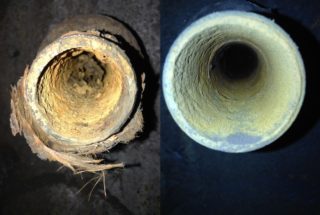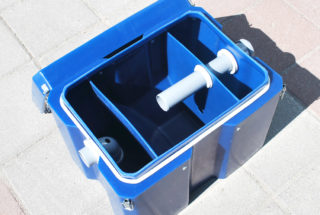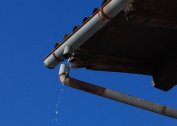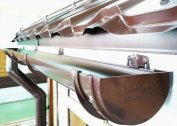An unpleasant odor from the drain hole, a decrease in the rate of draining the water or its complete stagnation are the most obvious signs of clogging of the sewer. Clogging can occur both due to the accumulation of fat, food debris, hair and other contaminants on the pipe walls, and due to improper installation and the absence of a standard bias to the riser. Can also provoke a blockage of metal salts present in water. Regardless of the reasons, you can and should try to cope with the problem yourself, without waiting for the moment when it will be necessary to call the plumbers team.
What is the essence of a mixed cleaning method
 With the mixed method of cleaning, a plunger or plumbing cable is used, in combination with folk or chemical means of combating blockages.
With the mixed method of cleaning, a plunger or plumbing cable is used, in combination with folk or chemical means of combating blockages.
Here is a simple example of a mixed sewer cleaning method:
- Pour a few liters of boiling water into the pipe.
- Wait 10-15 minutes.
- Eliminate clogging with a plunger.
- Pour 1/2 packet of baking soda into the drain and pour boiling water or 9% vinegar in a ratio of 1: 3.
- When choosing a variant with vinegar, make sure to plug a hole with a rag while waiting, because vinegar that enters into a chemical reaction with soda can produce a copious amount of foam.
- After 5-10 minutes, rinse the drain with plenty of water.
Option using soda in combination with salt:
- 1/2 cup of salt is mixed with 1 cup of soda and 1 cup of water.
- The resulting mixture is poured into the drain hole and left there for 10-15 minutes.
- Without rinsing, the drain is cleaned with a plunger.
- In case of incomplete cleaning of the blockage, the procedure is repeated.
By analogy with the methods described, a plunger or cable can be used in combination with a chemical agent.
- A cleaning agent is poured or filled into the intended place of blockage and the required amount of time is maintained, in accordance with the instructions.
- The pipe is thoroughly rinsed with hot water.
- In case of incomplete cleaning, a cable or plunger is used.
In this way, a double effect is achieved: thanks to the cleaning agent, the blockage is completely or partially dissolved, and the plunger or cable easily removes trash that caused the problem. For the best effect, pay attention to the composition of the selected detergent. Alkaline preparations are used to remove the accumulation of fat in the pipes in the kitchen, but for the bathroom it is better to choose an acid-based product, because it is specifically designed to dissolve organic waste such as hair and end products of the residents of the house.
Please note that plastic pipes, unlike cast iron and metal pipes, need a special approach. To clean them, it is not recommended to use boiling water and a steel cable to avoid rapid wear of rubber gaskets and mechanical damage to the pipe walls.
Pros and cons of the method compared to the rest
 The advantages of this method include:
The advantages of this method include:
- the ability to clean, without the use of chemicals with toxic fumes;
- high efficiency, in comparison with the use of only chemical or only mechanical cleaning methods;
- the ability to eliminate even insoluble blockage on their own, without resorting to the help of the plumbing service
- accessibility and cheapness, because there is a plunger or cable in every house, as well as vinegar and soda can be found in the kitchen of any housewife;
- chemicals are dangerous not only by inhalation of toxic fumes and chemical burns in case of contact with skin, but also by the ability to destroy the integrity of old cast-iron pipes.In the case of the choice of mixed cleaning using folk remedies, all these threats can be avoided.
The disadvantage of this method is only one: if the blockage is large enough and old, or if it is localized in a common riser, it is most likely not possible to fix the problem without the help of a plumber with specialized equipment. However, in such a situation, even powerful store tools will not help.
When to use the mixed method
 Consider situations where the mixed method is simply irreplaceable:
Consider situations where the mixed method is simply irreplaceable:
- Such cleaning can be used for preventive purposes, because it does not take a lot of time, and it can’t afford it. By regularly cleaning the pipes before clogging, you are guaranteed to protect the water supply from unforeseen clogging;
- the option with a plunger is perfect in case of clogging of plastic pipes and the inability to use aggressive chemicals at the same time;
- the use of cleaning products in combination with a steel cable will save in the event of insoluble clogging of metal or cast-iron pipes;
- if accumulation in the pipes of a blockage provoked by the ingress of foreign objects, it will be convenient to partially dissolve the blockage with a chemical agent or a combination of soda and vinegar, and remove the remains with a plunger or cable.
Future blockage prevention
Sewer blockage, like any other problem, is always easier to prevent than to eliminate the consequences of what has already happened. Depending on the causes, it is necessary to adhere to certain preventive measures and you will forget about the difficulties with sewage in the future.
Contact with garbage and small items
The most common cause of blockages is the ingress of food, hair, and sometimes even items such as a rag, sponge, or ear stick into the drain hole. The simplest prevention option is to use a mesh that traps debris. And of course, you shouldn’t intentionally throw foreign objects into the drain holes that can block the free flow of water.
Fat sticking inside the pipes
 In a system using cast iron pipes, over time, a layer of fat deposits on their inner surface, which leads to a gradual deterioration in the drain rate and the formation of a fetid odor. In order to prevent this from happening, you need to regularly rinse the plums with boiling water. A 200-300 gr. baking soda, filled before washing, will not only help better detach the growth, but also disinfect the pipes.
In a system using cast iron pipes, over time, a layer of fat deposits on their inner surface, which leads to a gradual deterioration in the drain rate and the formation of a fetid odor. In order to prevent this from happening, you need to regularly rinse the plums with boiling water. A 200-300 gr. baking soda, filled before washing, will not only help better detach the growth, but also disinfect the pipes.
It will also help to prevent the problem of installing a grease trap on the sewer, which will filter water from grease, oils and various solids that disrupt the normal operation of the pipeline and pollute the environment.
Accumulation of dirt and hair in a siphon
Plastic pipes, as a rule, do not suffer from fat sticking, because they have smoother walls. But their use has its own nuance - quite often hair and dirt accumulate on the bends of pipes, as well as in the siphon itself. From time to time, unscrew the siphon, throw out the accumulated debris from it and rinse with running water. This is not difficult to do, and the result will be protection against blockages, which may require a more thorough cleaning.
Installation Errors
Blockages in pipes can occur due to improper installation of the sewer system, even if all possible preventive measures are followed. Therefore, it is extremely important not to engage in self-installation, without having an accurate idea of all the subtleties necessary for the correct operation of the pipeline. Entrust this question to professionals and you will not have to face constant problems in the future to eliminate blockages.



